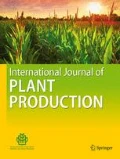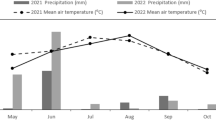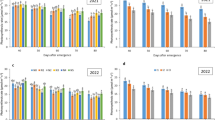Abstract
Attempts were made to study effects of planting techniques on crop dry matter (DM), intercepted photosynthetically active radiation (fIPAR), tuber yield (y), evapotranspiration (ET), water-use efficiency and y–ET relationship of potato under varying irrigation regimes. Field experiments were conducted for three seasons with four irrigation regimes: 2, 3, 4 and 5 numbers of irrigation per season (I1, I2, I3 and I4, respectively), and three planting methods: S1-normal single row planting with 50-cm row-to-row and 15-cm plant-to-plant spacing with 50-cm furrow spacing; S2-paired-row planting at 25-cm spacing, 75-cm furrow spacing; and S3-paired-row planting at 50-cm spacing with 100-cm furrow spacing. Though the highest tuber yield was recorded in I4, it was marginally higher than that in I3; whereas the highest WUE was obtained with I3. Optimum irrigation in I3 and I4 maintained higher crop DM, greater fIPAR, ET and better tuber formation than in I1 and I2. No significant yield reduction occurred due to paired-row method (S2); however, irrigation volume reduced by 21%; crop WUE increased by 8.2% and irrigation WUE increased by 21% in S2 compared with S1. The y–ET functions were found quadratic with downward concave; and elasticity of water production functions (Ewp) were used to reveal the dynamic relationship of y, ET and WUE. Findings suggest that the ET of 348 mm would be required to achieve maximum WUE of 44.11 kg ha−1 mm−1 with paired-row furrow irrigated system; and this would result in tuber yield of 15.42 t ha−1. Crop response factor (Ky) values indicated that tuber yield reduction would be directly proportional to reduced irrigation. Therefore, it is concluded that potato could be grown with paired-row method of planting at 75 × 20 cm spacing, and the ET demand of 348 mm should be met to achieve maximum tuber yield and increased WUE. The study could be an important reference for water-saving of potato production in tropical sub-humid conditions.




Similar content being viewed by others
Abbreviations
- DAP:
-
Days after planting
- DMRT:
-
Duncan’s multiple range test
- Ep :
-
Pan evaporation
- ET:
-
Evapotranspiration
- Ewp :
-
Elasticity of water production
- fIPAR:
-
Fraction of intercepted photosynthetically active radiation
- IWUE:
-
Irrigation water use efficiency
- LSD:
-
Least significant difference
- PAR:
-
Photosynthetically active radiation
- Ky :
-
Yield response factor
- RGR:
-
Relative growth rate
- R 2 :
-
Coefficient of determination
- WUE:
-
Water use efficiency
- WUEm :
-
Marginal water use efficiency
References
Alam, S., Islam, N., Hossain, J., Islam, M., Bhuiyan, S. R., & Hossain, I. (2016). Optimizing crop geometry for processing-grade tuber yield, quality and economics of potato in Grey Terrace Soil. Archives of Agronomy and Soil Science, 62, 1496–1507.
Alva, A. K. (2008). Water management and water uptake efficiency by potatoes: A review. Archives of Agronomy and Soil Science, 54, 53–68.
Aujla, M. S., Thind, H. S., & Buttar, G. S. (2005). Cotton yield and water use efficiency at various levels of water and N through drip irrigation under two methods of planting. Agricultural Water Management, 71, 167–179.
Buttar, G. S., Thind, H. S., & Aujla, M. S. (2006). Methods of planting and irrigation at various levels of nitrogen affect the seed yield and water use efficiency in transplanted oilseed rape (Brassica napus L.). Agricultural Water Management, 85, 253–260.
DAC&FW (2016). Horticultural Statistics at a Glance-. (2016). Horticulture statistics division, department of agriculture, cooperation and farmers welfare (p. 147). New Delhi: Ministry of Agriculture and Farmers Welfare, Government of India.
Dalla Costa, L., Delle Vedove, G., Gianquinto, G., Giovanardi, R., & Peressotti, A. (1997). Yield, water use efficiency and nitrogen uptake in potato: Influence of drought stress. Potato Research, 40, 19–34.
Doorenbos, J. & Kassam, A.H. (1979). Yield response to water. FAO Irrigation and Drainage Paper 33, Rome, Italy, p. 193.
Fabeiro, C., de Santa Olalla, F. M., & de Juan, J. A. (2001). Yield and size of deficit irrigation potatoes. Agricultural Water Management, 48, 255–266.
Ferreira, T. C., & Carr, M. K. V. (2002). Responses of potatoes (Solanum tuberosum L.) to irrigation and nitrogen in a hot, dry climate. Field Crops Research, 78, 51–64.
Ferreira, T. C., & Gonçalves, D. A. (2007). Crop-yield/water-use production functions of potatoes (Solanum tuberosum L.) grown under differential nitrogen and irrigation treatments in a hot, dry climate. Agricultural Water Management, 90, 45–55.
Gallo, K. P., & Daughtry, C. S. T. (1986). Techniques for measuring intercepted and absorbed photosynthetically active radiation in corn canopies. Agronomy Journal, 78, 752–756.
Gardner, F. P., Pearce, R. B., & Mitchell, R. L. (1988). Physiology of Crop Plants (pp. 200–203). Jodhpur: Scientific Publishers.
Gleick, P. H. (2003). Global freshwater resources: Soft-path solutions for the 21st century. http://www.sciencemag.org/search?author1=Peter+H.+Gleick&sortspec=date&submit=Submit Science, 302, 1524–1528.
Gleick, P. H., & Palaniappan, M. (2010). Peak water limits to freshwater withdrawal and use. PNAS, USA, 107, 11155–11162.
Gomez, K. A., & Gomez, A. A. (1984). Statistical procedures for agricultural research (pp. 97–107). UK: Wiley.
Haxem, R. W., & Heady, E. O. (1978). Water production functions for irrigated agriculture (p. 215). Ames, IA: Iowa State University Press.
Howell, T. A. (2001). Enhancing water use efficiency in irrigated agriculture. Agronomy Journal, 93, 281–289.
Islam, R., Hu, Y., Mao, S., Mao, J., Eneji, A. E., & Xue, X. (2011). Effectiveness of a water-saving super-absorbent polymer in soil water conservation for corn (Zea mays L.) based on eco-physiological parameters. Journal of the Science of Food and Agriculture, 91(11), 1998–2005.
Kang, Y., Wang, F. X., Liu, H. J., & Yuan, B. Z. (2004). Potato evapotranspiration and yield under different drip irrigation regimes. Irrigation Science, 23, 133–143.
Kar, G., & Kumar, A. (2007). Effects of irrigation and straw mulch on water use and tuber yield of potato in eastern India. Agricultural Water Management, 94, 109–116.
Kashyap, P. S., & Panda, R. K. (2003). Effect of irrigation scheduling on potato crop parameters under water stressed conditions. Agricultural Water Management, 59, 49–66.
Kaur, A., Kaur, A., & Singh, V. P. (2005). Moisture extraction pattern, consumptive use of water and water use efficiency of hybrid pearl millet as influenced by planting methods, mulching and weed control under rainfed conditions. Research on Crops, 6, 199–201.
King, B. A., Tarkalson, D. D., Bjorneberg, D. L., & Taberna, J. P., Jr. (2011). Planting system effect on yield response of russet norkotah to irrigation and nitrogen under high intensity sprinkler irrigation. American Journal of Potato Research, 88, 121–134.
Klute, A. (1986). Water retention laboratory methods. In: A. Klute (Ed.), Methods of soil analysis. Part 1. Physical and Mineralogical Methods (2nd edn.) (pp. 635–662). Madison, WI: Am Soc Agron, Soil Sci Soc Am.
Liu, W. Z., Hunsaker, D. J., Li, Y. S., Xie, X. Q., & Wall, G. W. (2002). Interrelations of yield, evapotranspiration, and water use efficiency from marginal analysis of water production functions. Agricultural Water Management, 56, 143–151.
Liu, F., Shahnazari, A., Andersen, M. N., Jacobsen, S. E., & Jensen, C. R. (2006a). Effects of deficit irrigation (DI) and partial root drying (PRD) on gas exchange, biomass partitioning, and water use efficiency in potato. Scientia Horticultura, 109, 113–117.
Liu, F., Shahnazari, A., Andersen, M. N., Jacobsen, S. E., & Jensen, C. R. (2006b). Physiological responses of potato (Solanum tuberosum L.) to partial root-zone drying: ABA signaling, leaf gas exchange, and water use efficiency. Journal of Experimental Botany, 57, 3727–3735.
Mandal, K. G., Hati, K. M., Misra, A. K., & Bandyopadhyay, K. K. (2006). Assessment of irrigation and nutrient effects on growth, yield and water use efficiency of Indian mustard (Brassica juncea) in central India. Agricultural Water Management, 85, 279–286.
Mandal, K. G., Hati, K. M., Misra, A. K., Bandyopadhyay, K. K., & Tripathi, A. K. (2013). Land surface modification and crop diversification for enhancing productivity of a Vertisol. International Journal of Plant Production, 7, 455–472.
Mohsin Iqbal, M., Mahmood Shah, S., Mohammad, W., & Nawaz, H. (1999). Field response of potato subjected to water stress at different growth stages. In C. Kirda, P. Moutonnet, C. Hera, & D. R. Nielsen (Eds.), Crop yield response to deficit irrigation (pp. 213–223). Dordrecht, Boston, London: Kluwer Academic Publishers.
Monaghan, J. M., Daccache, A., Vickers, L. H., Hess, T. M., Weatherhead, E. K., Grove, I. G., et al. (2013). More ‘crop per drop’: constraints and opportunities for precision irrigation in European agriculture. Journal of the Science of Food and Agriculture, 93, 977–980.
More, S. M., & Bhoi, P. G. (2004). Economic analysis of suru sugarcane (CO-86032) and its ratoon under drip irrigation and wide row planting system. Indian Sugar, 54, 447–452.
Nelson, D. W. & Sommers, L. E. (1996). Total carbon, organic carbon, and organic matter. In: D. L. Sparks (Ed.), Methods of soil analysis. Part 3: Chemical methods (pp. 961–1010). Madison, WI: Soil Sci Soc Am.
Page, A. L., Miller, R. H. & Keeney, D. R. (1982). Method of soil analysis. Part 2. Chemical and microbiological properties, 2nd edn. Madison, WI: Agronomy Monographs, ASA and SSA.
Panigrahi, B., Panda, S., & Raghuwanshi, N. (2001). Potato water use and yield under furrow irrigation. Irrigation Science, 20, 155–163.
Passioura, J. (2006). Increasing crop productivity when water is scarce- from breeding to field management. Agricultural Water Management, 80, 176–196.
Paul, S., Farooq, M., Bhattacharya, S. S., & Gogoi, N. (2017). Management strategies for sustainable yield of potato crop under high temperature. Archives of Agronomy and Soil Science, 63, 276–287.
Philippe, D., & Abdellah, A. (2004). Adaptation of crop management to water-limited environments. European Journal of Agronomy, 21, 433–446.
Porter, G. A., Bradbury, W. B., Sisson, J. A., Opena, G. B., & McBurnie, J. C. (1999). Soil management and supplemental irrigation effects on potato: I. Soil properties, tuber yield, and quality. Agronomy Journal, 91, 416–425.
Ramesh, T., & Devasenapathy, P. (2007). Natural resources management on sustainable productivity of rainfed pigeonpea (Cajanus cajan L.). Research Journal of Agricultural and Biological Sciences, 3, 124–128.
Shahnazari, A., Liu, F., Andersen, M. N., Jacobsen, S. E., & Jensen, C. R. (2007). Effects of partial root-zone drying on yield, tuber size and water use efficiency in potato under field conditions. Field Crops Res, 100, 117–124.
Shivay, Y. S., & Singh, R. P. (2003). Effect of nitrogen levels on productivity of grain legumes intercropped with maize (Zea mays). Legume Research, 26, 303–306.
Shock, C. C., & Feibert, E. B. G. (2002). Deficit irrigation of potato. In Food and Agricultural Organization of the United Nations (FAO) (Ed.), Deficit Irrigation Practices (pp. 47–56). Rome: FAO.
Tarkalson, D. D., King, B. A., Bjorneberg, D. L., & Taberna, J. P., Jr. (2011). Evaluation of in-row plant spacing and planting configuration for three irrigated potato cultivars. American Journal of Potato Research, 88, 207–217.
Tilman, D., Cassman, K. G., Matson, P. A., Naylor, R., & Polasky, S. (2002). Agricultural sustainability and intensive production practices. Nature, 418, 671–677.
Wallace, J. S. (2000). Increasing agricultural water use efficiency to meet future food production. Agriculture, Ecosystems and Environment, 82, 105–119.
Wallace, J. S., & Batchelor, C. H. (1997). Managing water resources for crop production. Philosophical Transactions Royal Society London B, 352, 937–947.
Wang, H., Liu, F., Andersen, M. N., & Jensen, C. R. (2009). Comparative effects of partial root-zone drying and deficit irrigation on nitrogen uptake in potatoes (Solanum tuberosum L.). Irrigation Science, 27, 443–448.
Wang, Z., Zerihum, D., & Feyen, J. (1996). General irrigation efficiency for field water management. Agricultural Water Management, 30, 123–132.
Acknowledgements
The project was supported by the ICAR-Indian Institute of Water Management, Bhubaneswar, India. We thank our colleague Dr. S.K. Rautray and Dr. R.K. Mohanty for critical review of the manuscript. Authors also thank anonymous reviewers for their constructive comments to improve the manuscript.
Author information
Authors and Affiliations
Corresponding author
Rights and permissions
About this article
Cite this article
Mandal, K.G., Thakur, A.K. & Mohanty, S. Planting Techniques and Irrigation Influenced Crop Growth, Light Interception and Yield–Evapotranspiration Relationship of Potato. Int. J. Plant Prod. 12, 285–296 (2018). https://doi.org/10.1007/s42106-018-0026-y
Received:
Accepted:
Published:
Issue Date:
DOI: https://doi.org/10.1007/s42106-018-0026-y




